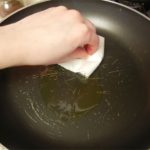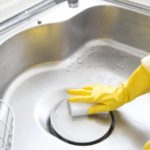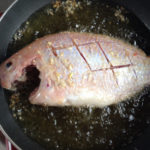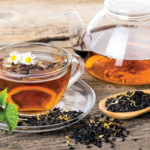Non-stick pan is a very familiar utensil in every family’s kitchen. This tool helps you to cook delicious fried and stir-fried dishes, and it can even replace the oven to make cakes.

What is a non-stick pan?
Non-stick coating material on non-stick pan
Ceramica (Ceramic)
The types of pans that are coated with ceramica have prominent advantages:
- Ceramic is made from 100% inorganic minerals and oxides with the characteristics: Scratch-resistant, heat-resistant, durable, beautiful gloss.
- This is a smooth ceramic coating that can withstand high temperatures and is absolutely safe for health.
- Ceramic non-stick pans have the ability to distribute heat evenly and are not affected by chemicals.
- Ceramic is now applied to most cooking utensils such as pans, pots, rice cookers, etc.
- The ceramic non-stick coating does not contain PTFE or PFOA, which is safe for consumers’ health.
- This non-stick material is also environmentally friendly as it uses less energy in the production process.
- Ceramic-coated pans are currently the safest non-stick pans.

Teflon
The outstanding advantages of pans coated with Teflon non-stick coating are:
- Teflon non-stick coating has remarkable characteristics: Heat resistance, chemical resistance, corrosion resistance, very good non-stick properties.
- Thanks to its high durability and non-stick life, Teflon has been used as a non-stick coating in over 40 countries.
- Teflon decomposes at temperatures of 300 – 400 degrees Celsius, while cooking temperatures usually range from 130 – 190 degrees Celsius.
- Teflon is a compound that is difficult to absorb, it will be excreted without being absorbed into the body. So you don’t have to worry about Teflon accumulating and causing diseases!
- In fact, only the adhesive between Teflon and metal is harmful to health, so do not use pans with peeling non-stick coating.
- Teflon-coated pans are currently the most durable non-stick pans.

Quartz Stone
Pans with a non-stick coating of quartz stone have prominent advantages:
- The surface of the pan is cast with a hard steel layer with a diamond-shaped pattern that prevents sticking and scratching.
- Quartz stone pans have good antibacterial properties, especially you do not need to add oil when frying or stir-frying food.
- The non-stick coating does not contain PTFE or PFOA, which is environmentally friendly and safe for users.
- The surface of this type of pan is coated with up to 5 layers of non-stick coating: Layer 1 (Marble) helps prevent bacteria, scratches and sticking. Layer 2 (Whitford) helps save cooking oil. Layer 3 increases the durability of the non-stick coating. Layer 4 (pure aluminum) and the final layer is a paint layer that helps prevent oxidation.
- Quartz stone non-stick pans are heavier compared to other types of pans.

Greblon
This non-stick material has remarkable advantages:
- Greblon contains high molecular weight PTFE compounds, which have good resistance in many environments, do not contain PFOA, APEO, and have high non-stick properties.
- Pans coated with a greblon non-stick coating are certified safe for food and human health according to the LFGB standard of Germany. This result is also accepted by European countries.
- This greblon non-stick coating pan can be used for continuous cooking at temperatures < 230 degrees Celsius, at 230 - 250 degrees Celsius, it should only be cooked for 15 to 20 minutes.
The outstanding advantages of pans coated with Whitford non-stick coating are:
- Whitford non-stick coating material is mainly composed of PTFE, does not contain PFOA and APEO, ensuring high non-stick properties, and has good resistance in many environments.
- This material meets the FDA standards of the United States and is certified safe for direct contact with food.

Instructions on how to use a non-stick pan for the first time
Clean the pan after buying it
– Step 1: When you bring the pan home, the first step is to pour some water into the pan, about 2/3 of the pan is enough, no need to fill it up.
– Step 2: Then you turn on a high heat to boil the water in the pan. You only need to boil the water until you see a lot of steam rising, not boiling vigorously.
– Step 3: Then turn off the stove and pour out the water.
– Step 4: Then use a paper towel to clean the remaining water in the pan.

Prevent peeling of the pan
– Step 5: Next, you put the pan on the stove and turn the heat to the lowest possible.
– Step 6: Then pour a little cooking oil onto a paper towel.
– Step 7: Use the oil-absorbing paper towel to wipe the pan. Wipe the pan evenly for about 30 seconds, then turn off the stove and let the pan cool.



































